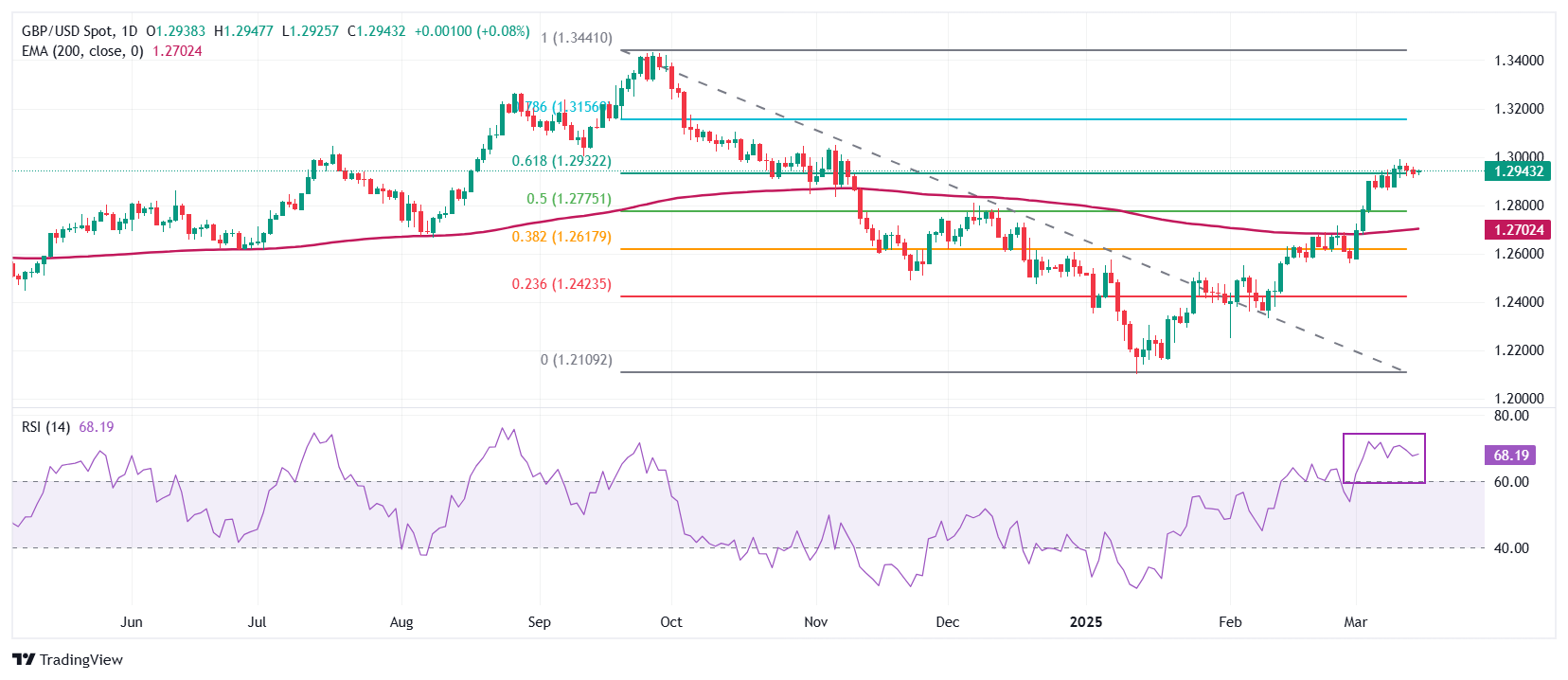- The Pound Sterling climbs toward 1.2970 against the US Dollar as investors anticipate the Fed and BoE monetary policy decisions this week.
- US officials, including President Donald Trump, warn of potential economic turbulence due to new policy measures.
- The UK economy shrank by 0.1% in January, with factory output experiencing a sharp decline.
The Pound Sterling (GBP) surges toward 1.2970 against the US Dollar (USD) at the start of the week, supported by a weaker USD Index, which has slipped to around 103.50. Investors remain cautious ahead of key monetary policy decisions from the Federal Reserve (Fed) on Wednesday and the Bank of England (BoE) on Thursday, with both central banks widely expected to hold interest rates steady.
The CME FedWatch tool indicates that the Fed is almost certain to maintain its current borrowing rate of 4.25%-4.50%, marking the second consecutive meeting with no changes. Traders anticipate a cautious stance from Fed officials, who have emphasized a “wait and see” approach amid economic uncertainty under US President Donald Trump’s administration.
Market sentiment suggests that Trump’s economic policies could fuel inflation while weighing on near-term growth. The latest University of Michigan (UoM) consumer survey for March revealed a rise in five-year inflation expectations to 3.9% from 3.5% in February, while the preliminary Consumer Sentiment Index dropped sharply to 57.9 from 64.7, missing forecasts of 63.1.
Several US officials, including President Trump, Commerce Secretary Howard Lutnick, and Treasury Secretary Scott Bessent, have acknowledged potential economic turbulence from Trump’s policies but maintain that they are essential for long-term national growth. In a Sunday interview with NBC News, Bessent stated, “We are implementing robust and durable policies, and while adjustments may be needed, reducing dependence on massive government spending is crucial.” His remarks followed questions about whether Trump’s agenda could push the US economy into a recession.
Daily Market Movers: Pound Sterling Awaits UK Employment Data
- The Pound Sterling trades cautiously against major currencies during European trading hours on Monday as investors brace for the Bank of England’s (BoE) monetary policy announcement on Thursday. Market expectations suggest that the BoE will maintain interest rates, with policymakers signaling a “gradual and cautious” approach toward potential rate cuts.
- Traders will closely analyze the monetary policy statement and BoE Governor Andrew Bailey’s press conference for insights into the central bank’s economic outlook and future policy direction.
- Concerns over the UK’s economic health have intensified following a contraction in monthly Gross Domestic Product (GDP) and a sharp decline in January’s Industrial and Manufacturing Production data. Additionally, in its February policy meeting, the BoE halved its GDP growth forecast to 0.75%, adding to economic uncertainty.
- This week, attention will also turn to the UK labor market data for the three months ending in January, set for release on Thursday. Investors will closely watch the Average Earnings data, a crucial measure of wage growth and a key driver of inflation in the services sector, as it could influence the BoE’s future policy decisions.
Technical Analysis: Pound Sterling Holds Above 1.2950

The Pound Sterling continues its upward momentum, aiming to reclaim the key psychological level of 1.3000 against the US Dollar in Monday’s European session. The long-term outlook for GBP/USD remains bullish, with the pair trading above the 200-day Exponential Moving Average (EMA), currently around 1.2700.
The 14-day Relative Strength Index (RSI) remains above 60.00, signaling strong bullish momentum.
On the downside, key support levels are found at the 50% Fibonacci retracement level of 1.2775 and the 38.2% Fibonacci retracement level of 1.2618. Conversely, on the upside, the October 15 high of 1.3100 serves as a crucial resistance zone.





